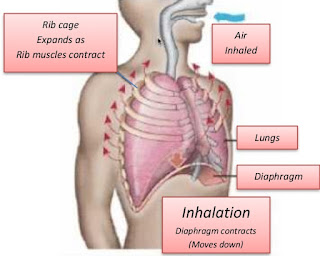Lesson Plan of Respiratory System General Science Grade VII
Lesson Plan of Respiratory System
General Science Grade VII
Students’ Learning Outcomes
·
Describe the mechanism of
respiration in humans.
Information for Teachers
·
Many animals possess special
breathing mechanisms which increase the rate of exchange of gases between the
animals and the external environment.
·
The movement of air into and
out of the lungs, called “ventilation” renews the oxygen supply in the lungs
and removes the surplus carbon dioxide.
·
Breathing is a part of
respiration in which air is inhaled and exhaled from the lungs.
Concept Map
Material / Resources
Charts showing breathing mechanism a large
plastic bottle, vinyl tube of about 6 mm straw used for two balloons, plastic
bags, thread, rubber band, plasticizes, a pair of scissors, plastic bottle.
Worm up activity
·
Call one student in front of
the class.
·
Ask the student to take a
deep breath and ask the other students to follow the same instruction.
·
Now ask them what they did?
(Expected response: They take
in and give out the air)
·
Ask the students to put their
hand on their chest and feel the change in the thoracic cavity.
·
After the students response
introduce the today’s topic that how the thoracic cavity helps in inhaling and
exhaling.
Development
Activity 1
·
Show the model / chart of
human respiratory system.
·
Ask the students to point out
/ identify parts of the respiratory system.
·
Talk about the path or way of
air in respiratory system.
·
Draw the path way of air on
the board by students instruction and ask them to
Activity 2
·
Show a chart or draw on the
board a diagram of the thoracic cavity.
·
Ask the students to inhale
air and ask:
o When you inhale, do your ribs move outwards or
inwards?
o Will the diaphragm move upwards or downwards on
inhaling are?
·
Now ask the students to
exhale air and ask:
o When you exhale, do your ribs move outwards or
inwards?
o On exhalation, will the diaphragm move upwards
or downwards?
·
Inform the students that the
capacity volume of the thoracic cavity will increase during inhalation and
decrease during exhalation.
Activity 2
·
Prepare a model as shown in
figure.
·
Ask the students to pull the
rubber sheet/balloon attached at the base of the model representing the lungs
carefully while diaphragm is being pulled downwards.
·
Ask the following questions
to involve the students:
o What happens to the balloon representing the
lungs?
o On inhalation, will the diaphragm move upwards
or downwards?
o What happens when the diaphragm (rubber sheet)
is pull down?
o What happens when the diaphragm (rubber sheet)
is relaxed?
o What is the relationship between movement of
diaphragm (rubber sheet) and lungs (balloons)?
Sum up / Conclusion
·
Sum up the lesson by telling
the students that breathing is a part of respiration in which air is inhaled
and exhaled from the lungs.
·
When air enters the lungs it
is called inspiration and when air is removed from the lungs it is called
expiration.
Assessment
·
Draw the given table on the
board and ask the students to copy on their notebooks.
·
Ask the students to fill the
table that how do parts of thoracic cavity help in inhaling and exhaling?
Parts of thoracic cavity
|
Inhalation
|
Exhalation
|
Ribs
|
||
Diaphragm
|
·
Ask the following questions
to enhance their learning.
o Which contains more oxygen inhaled air or exhaled
air?
o What is gaseous exchange?
o What happens in your lungs?
o Why does exhaled air have more carbon dioxide
than inhaled air?
Follow up
·
Ask the students to prepare a
model at home by joining 4 cards strips with thumb pins as shown in the figure.
·
Ask the students to bring
their model next day and share the working and mechanism of breathing with
their class fellows.









Thanku
ReplyDeleteAppreciable👍👏👏
ReplyDeleteThank you for sharing ideas
ReplyDeleteAwesome
ReplyDeleteUpload some more this type of science lesson plan
ReplyDeletevery engaging lesson/activity for the students..and helpful for the teachers
ReplyDeleteVery good L.P. it enganges learners more which is very nice
ReplyDelete